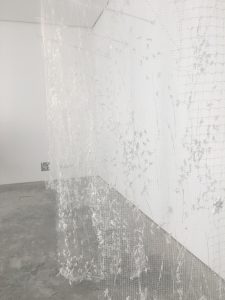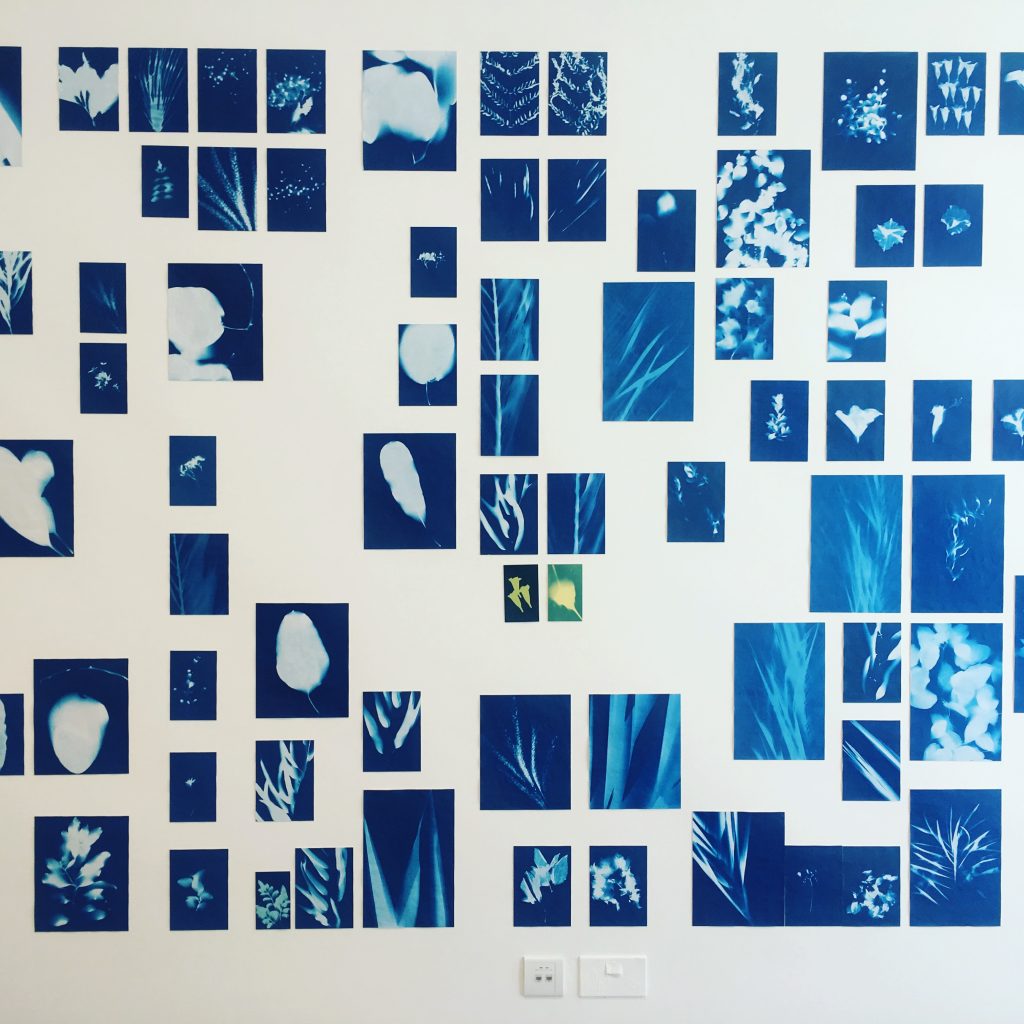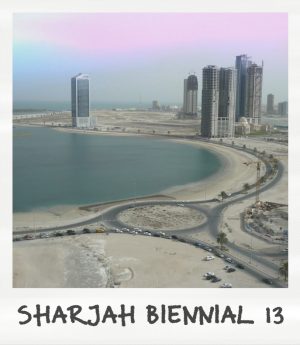Between 500-1000 CE, ships traveled from what is now China, stopping on the coasts of Vietnam, Sumatra, and India on their way to various ports of call along the Strait of Hormuz, the Red Sea coast, or the East African coast including Zanzibar and Mogadishu. For this reason, the Arab/Persian Gulf has long been a space of flows, of transfers, of crisscrossing networks. It makes sense that a biennial in the United Arab Emirates (UAE) would be deeply marked by – and contribute to – various regional conversations: for example, artists from the Gulf region follow the Kochi Biennial as much as they do Marrakesh’s.
The concept for the 13th Sharjah Biennial, themed Tamawuj, is related to waves and undulations, and simultaneously avoids and embraces the idea of site by hosting interventions in Sharjah as well as in Dakar, Ramallah, Istanbul and Beirut.
Founder of the Sharjah Art Foundation, Shaikha Hoor al Qassimi writes, “With Tamawuj, Christine [Tohme] challenges our notion of site – questioning the conventionally localized character of a biennial by proposing an extension of our work across time and space.” The idea of a site that is at once universal and particular resonates with my experience of the UAE: it is a nation that contains multitudes of nations. In what follows, I highlight works from the show that struck me, as an anthropologist who has spent the past 18 months in the UAE conducting fieldwork with artists, gallerists, and curators, as particularly relevant to the country’s local context.
Since the 2007 announcement of the construction of the Louvre and Guggenheim in Abu Dhabi, there has been a pointed, international media focus on arts in the UAE. Efforts were recently made to excavate a local history of artistic production; one that parallels, if not dovetails, with a more global history of contemporary art. A few events are usually cited in this genealogy: first, the Emirates Fine Arts Society was founded in 1980. The late Hassan Sharif returned from art studies in London in 1984 and formed an atelier, mentoring generations of UAE-based artists in subsequent years.[1] Sharjah’s first biennial was in 1993, but changed course significantly in 2003 when Shaikha Hoor al Qassimi returned from studies in London and took the helm. Organizers realized they needed an organization to operate year-round, in anticipation of the next biennial, but also to build local support and appreciation. Thus the Sharjah Art Foundation came into being in 2009: an institution born of a biennial. The region’s first commercial art fair, the Gulf Art Fair was established in 2007 and subsequently renamed Art Dubai.
Indeed, the question of infrastructure looms large in the UAE, as a biennial organization becomes an art foundation, as major museums are under construction, and as Dubai’s commercial galleries continue to proliferate. These constellations of businesses, works, and individuals, raise the question of how we organize knowledge, and how these emergent organizations and institutions structure our experience and our ability to see. Additionally the whole system is regulated such that some individuals, artists, et al., can live and work in the UAE, and some can’t. Works of art can more often enter the country than their makers themselves.
Two works in the Sharjah Biennial particularly illustrate this point: Uriel Orlow’s The Crown Against Mafavuke (2016) video installation re-enacts the trial of a South African herbalist tried by the British Crown for dispensing treatments drawn from both Western and traditional medicine in 1940. The work forces the viewer to parse regimes of knowledge, and to consider which organizations and people can present, benefit from, and commodify various forms of knowledge. Ali Jabri’s magnificent Untitled (1989-92) collage boxes are displayed on a table such that viewers must peer downwards into them, harkening back to the cabinets of curiosity, or wunderkammer, that often adorned the homes of Renaissance and Enlightenment era nobles. It is through grouping and linking practices, like Jabri’s assembling of diverse materials, that systems of knowledge – epistemes, in Foucault’s terms – are formed, and shape and foreclose different ways of thinking and knowing.
The biennial falters slightly in charting between local and international audiences, between national representation and a “global contemporary.” Biennials of course represent their respective nation and city, and therefore address audiences that are both global and local. But how should a biennial relate to its local context, or does it need to at all? Does a biennial require a kind of local anchor to be relevant, or is the audience more broad? Given the international media hype around the arts in the UAE, it is noteworthy that only three artists based in UAE were invited to participate (Abdullah Alsaadi, Hind Mezaina, and Vikram Divecha).

There is also the question of which cities and institutions hold biennials and how they represent a nation, a reflection prompted by Walid Siti’s False Flags (2017). As described in the accompanying wall text, False Flags highlights our “fragile attachment to iconic emblems of identity” and the ways that states harness the symbolism of flags in the name of oppression and war.
Another installation, Deniz Gul’s Fractals for Light (White on white) (2017), resembles a topographical map, and yet it is not: Gul arranged neon tubing hovering over mounds of white sugar on the floor. The viewer soon realizes the two pieces are not aligned, navigating the schism between representation of geographies and their boundaries and yet the absence of both, at the same time.
Life in the UAE is marked by extremely rapid change, and many artists based in the country interrogate these processes in their work, including Hind Mezaina. Her series Dubai Gardens (2017) consists of cyanotypes of foliage and plant life collected across the city. The title sounds like a paradox, given Dubai is a city in a desert, but it cleverly alludes to and mimics the idyllic names of many Dubai neighborhood complexes: Meadows, Springs, Ranches, etc. Mezaina’s project is an attempt to diversify and nuance representations of a city that is often presented as spectacular, larger-than-life metropolis, full of steel-and-glass skyscrapers. Because she is also working with cyanotypes, which require more time than photographs to capture, these works challenge assumptions about speed of processing.

Allora and Calzadilla’s The Great Silence (2014) is a video installation where artists have subtitled an imagined conversation between parrots, and viewers hear the birds reflecting on their impending extinction. The parrots note, “It’s likely that we’ll die before our time and join the great silence.” The process of extinction has accelerated; the beauty of Allora and Calzadilla’s intervention is to highlight humans’ ignorance of all that we are losing, as we do not typically ascribe logic and communication to other beings.
Tamawuj shows several other thought-provoking works that merit further attention, including: Rain Wu and Eric Chen’s installation Collectivism (2016), an assemblage of 600 interlocked police shields around a garden; Paola Yacoub’s Sabil Kuttab Automate (2017) reinterpretation of ancient water preservation systems; Abdelkader Benchamma’s Neither the sky nor the earth (2017) cave-room; Kader Attia’s Mimesis as Resistance (2013) film of lyrebirds’ survival through mimcry; and Ursula Biemann and Paulo Tavares’ Forest Law (2014) research room.
Hosted in an established hub of transit and trade, Tamawuj presented an opportunity to draw from and represent the UAE and its diverse communities. While the show attempts to address the distinction between the local and the global, it felt detached; few works focused on change, representation, and knowledge production pertaining to the local context. While the four key themes (water, earth, crops, and the culinary) are invoked in other locales (Dakar, Ramallah, Istanbul, and Beirut, respectively) they were not represented in or for Sharjah. Perhaps over time, the “reciprocal exchange” Tohme invokes will come to be, or it will ebb and flow.
- Two recent exhibitions have made significant strides in defining this history: 1980-Today: Contemporary Art in the United Arab Emirates, curated by Hoor al Qasimi and shown at the Venice Biennial 2015 and at the Sharjah Art Foundation in 2016; and But We Cannot See Them: Tracing a UAE Art Community 1988-2008, curated by Maya Allison at the New York University Abu Dhabi Art Gallery, held in 2017 ↑


